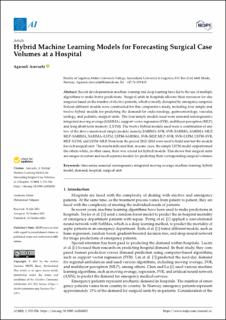| dc.description.abstract | Abstract Recent developments in machine learning and deep learning have led to the use of multiple algorithms to make better predictions. Surgical units in hospitals allocate their resources for day surgeries based on the number of elective patients, which is mostly disrupted by emergency surgeries. Sixteen different models were constructed for this comparative study, including four simple and twelve hybrid models for predicting the demand for endocrinology, gastroenterology, vascular, urology, and pediatric surgical units. The four simple models used were seasonal autoregressive integrated moving average (SARIMA), support vector regression (SVR), multilayer perceptron (MLP), and long short-term memory (LSTM). The twelve hybrid models used were a combination of any two of the above-mentioned simple models, namely, SARIMA–SVR, SVR–SARIMA, SARIMA–MLP, MLP–SARIMA, SARIMA–LSTM, LSTM–SARIMA, SVR–MLP, MLP–SVR, SVR–LSTM, LSTM–SVR, MLP–LSTM, and LSTM–MLP. Data from the period 2012–2018 were used to build and test the models for each surgical unit. The results indicated that, in some cases, the simple LSTM model outperformed the others while, in other cases, there was a need for hybrid models. This shows that surgical units are unique in nature and need separate models for predicting their corresponding surgical volumes. View Full-Text Keywords: time series, seasonal autoregressive integrated moving average, machine learning, hybrid model, demand, hospital, surgical unit | en_US |

